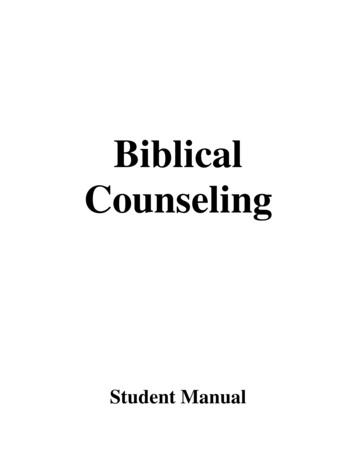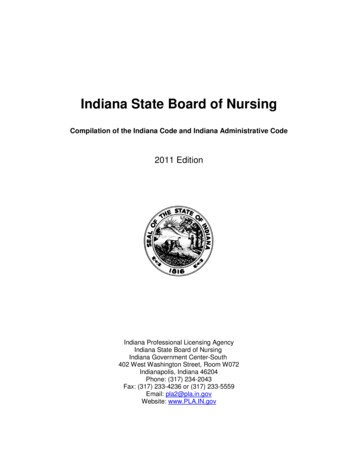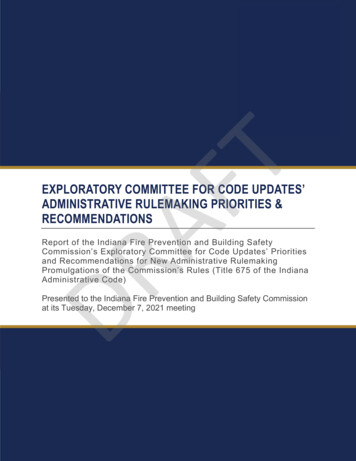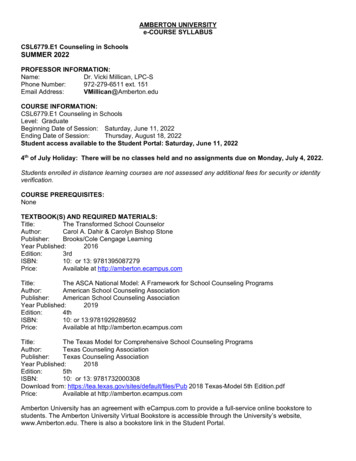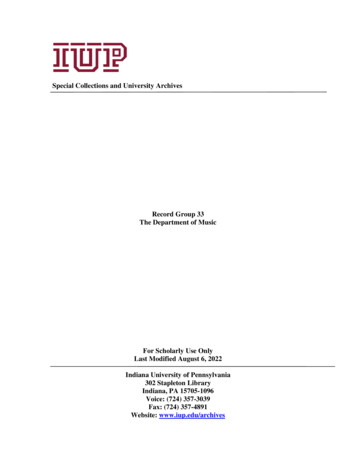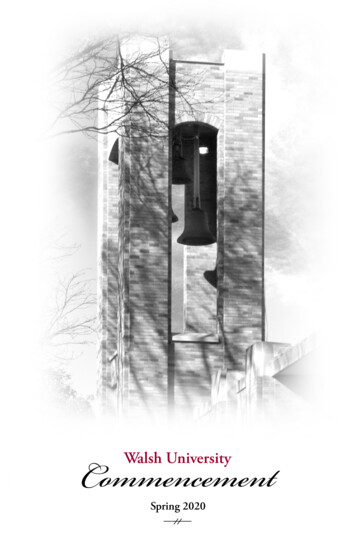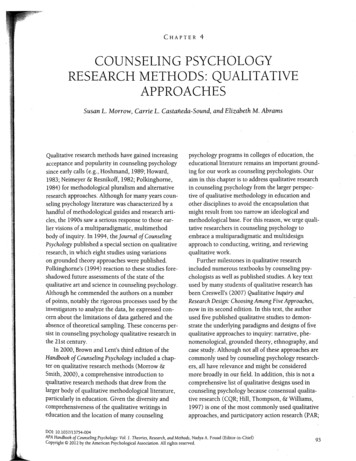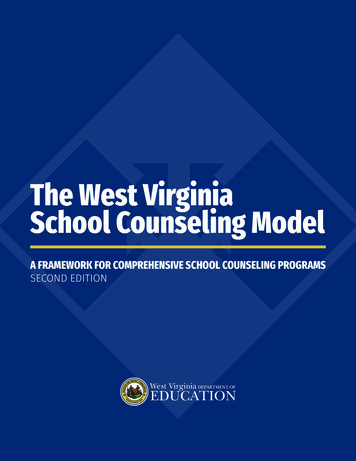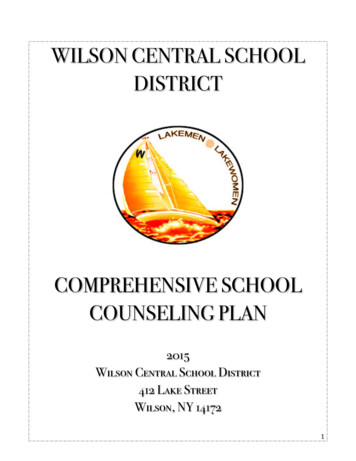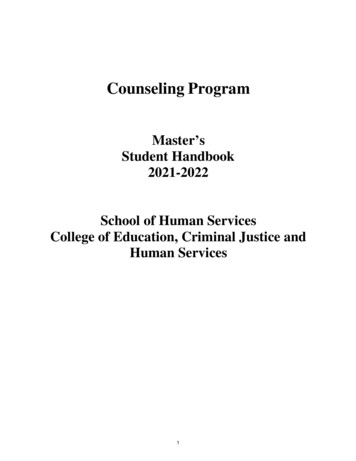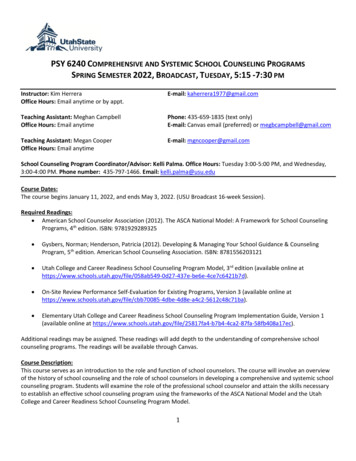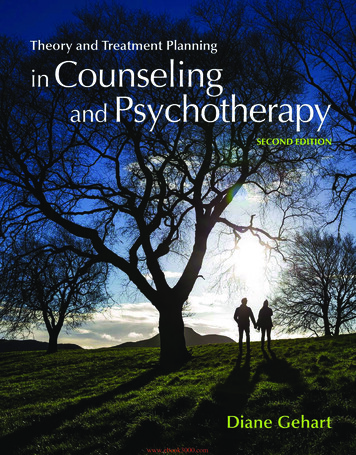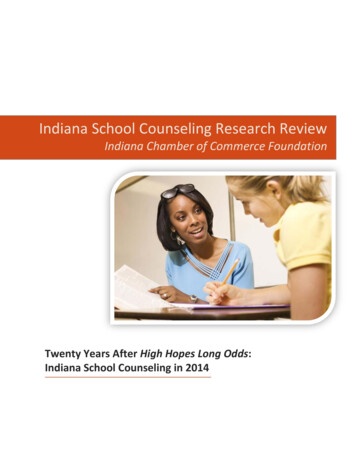
Transcription
Indiana School Counseling Research ReviewIndiana Chamber of Commerce FoundationTwenty Years After High Hopes Long Odds:Indiana School Counseling in 2014
Indiana School Counseling in 2014This report was commissioned by the Indiana Chamber of Commerce Foundation. It wasproduced by Matt Fleck of Fleck Education and the Partnership for College and CareerReadiness, an organization with the primary aim of improving the college and career readinessof students through programs, resources and support of school counselors. March 2014.Spring 20142
Indiana School Counseling in 2014IntroductionThis report is a summary of a research review conducted for the Indiana Chamber of CommerceFoundation during the winter and spring of 2014 to assess the current state of school counselingin Indiana.A guiding question of the review was whether school counseling has changed much since 1994when a statewide study titled High Hope Long Odds identified disparities in the way counselorsprovided college and career readiness to students.This study addresses that question through a review of stateand national school counseling trends, research and currentconditions. It also summarizes the comments of 11 personalinterviews with key educational leaders in the state and theresults of a December 2013 of more than 425 Indiana schoolcounselors.Special thanks are extended to the Indiana school counselorswho responded so quickly and enthusiastically to thestatewide survey, the 11 state leaders who generously gaveof their time to be interviewed for this report and to theIndiana Chamber of Commerce Foundation for exploring thecomplex but vital condition of school counseling in Indiana.Spring 20143
Indiana School Counseling in 2014Table of ContentsPart 1: Foundations of Indiana School Counseling . 5Part 2: Views from Indiana Leaders . 21Part 3: Views from Indiana School Counselors . 39Appendices:Appendix A: Sources . 57Appendix B: Interview Questions . 58Appendix C: Indiana School Counselor CCR Survey . 59Appendix D: Career Resources, Materials and Websites . 61Appendix E: Career Resources, Materials and Websites . 65Appendix F: Non-Counseling Duties . 68Appendix G: Evening and Summer Hours Survey . 69Appendix H: Answers to “What would help you most to be more effective” . 74Spring 20144
Indiana School Counseling in 2014Part 1:Foundations of Indiana SchoolCounselingSpring 20145
Indiana School Counseling in 2014Spring 20146
Indiana School Counseling in 2014A Brief History of School CounselingSchool counseling emerged as “vocationalguidance” at the beginning of the 20thcentury amid an educational reformmovement that was intended, in part, onimproving the preparation of students forthe workplace (Gysbers, 2001).Though several vocational guidance effortswere underway across the country as earlyas 1895, Frank Parsons is credited as the“primary architect” of vocational guidance(Herr, 2010). Parsons felt “too manypeople were not able to effectively usetheir abilities, or to prosper economicallyand socially because of the haphazard waythey found work.” Parsons proposed athree-part process to maximize human talent by more efficiently identifying workthat matched a student’s strengths and interests (Parsons called it the trait and factorapproach).School counseling hasbeen seen to havedifferent types ofrelevance to schoolsdepending on the needsof the nation in differenthistorical periods.- Herr, 2001Vocational guidance grew along withthe broadening vocational educationreform movement of the early 1900s.Without effective guidance systemsto “insure [students] safe andefficient arrival on the job” it was feltthat the entire reform movementwas incomplete (Stephens, 1970).By the early 1920s, the emphasis onvocational guidance began shifting to“educational guidance” incorporatingnew research on child development,progressive education and mentalhealth (Herr, 2010).Carl Roger’s book “Counseling andPsychotherapy” in 1942 fueled theexpansion of guidance to include “counseling” by incorporating more theoretical andtherapeutic ideas. But with the launch of Sputnik and the passage of the NationalDefense Education Act of 1958, the purpose of guidance was redefined as “theSpring 20147
Indiana School Counseling in 2014identification and counseling of scientifically talented students” (Herr, 2010) theintent of ensuring more students were prepared for and entering college.A greater awareness of substance abuse, school violence and family issues in the1960s combined with new federal funding for vocational education and guidance“pulled and tugged at defining the purpose of guidance in the schools and role ofschool counselors” (Gysbers, 2001).For the last 50 years, that tension between whether school counseling is designed tohelp students prepare for work, to enter college or overcome social/emotionalchallenges has remained. The common term “guidance counseling” was coined as away of melding the mental health and career/college preparation purposes of theprofession into one phrase. But even that term is not without controversy. Thoughin wide use, many in the profession bristle at the title “guidance counselor”preferring instead to be called a “school counselor.”National and State Models of School CounselingVarious models have been developed over the years to organize and define the roleof school counselors and school counseling programs. The original vocational/careerfocus of school counseling in the early 20th century transformed into a more clinicalmodel emphasizing mental health counseling beginning in the 1920s and 1930sbefore changing again to a school-oriented, “pupil personnel services” model by the1960s.ASCA National ModelArguably the most successful model today is the ASCA National Model from theAmerican School Counselor Association which was based on the work of Gysbers andMoore (2001) in the 1970s. The national model provides a framework for astructured, organized and comprehensive approach of working with students basedon the developmental stages of youth.The ASCA National Model is comprised of four key components: Foundation. Developing a school counseling program philosophy andmission statement and using domains (academic, career andpersonal/social) and national student standards. Delivery System. The four methods used to reach students include:o School Guidance Curriculum – A developmental, comprehensiveguidance program based on student standards for grades K-12delivered in a systematic wayo Responsive Services – Addressing the personal/social preventionand intervention needs of studentsSpring 20148
Indiana School Counseling in 2014o Individual Student Planning – Assisting students and parents increating academic and career plans, scheduling, goal-setting andpreparing for transitionso System Support – The “behind the scenes” activities directlysupporting school counseling program delivery Management System. Methods for organizing time, data, schedules andcommunity communication and input through an advisory council. Accountability. Processes for collecting data on how students are impactedby the school counseling program and the overall effectiveness of schoolcounselors.Spring 20149
Indiana School Counseling in 2014Indiana School Counseling ModelIn the early 1980s before the national model was developed, the Indiana SchoolCounselor Association (ISCA), in collaboration with the Indiana Department ofEducation and other stakeholders, developed a comprehensive school counselingframework called the Indiana Development School Counseling Model. Like thenational model, Indiana’s model sought to better organize the various duties ofcounselors into an intentional, logical structure. Student standards were developedin the areas of academic learning, work preparation and overcoming social/personalbarriers.In the early 1990s, Indiana’s model was revised and renamed the Gold Star SchoolCounseling model based on nine newly developed Indiana Program Standards forSchool Counseling including:Standard 1.Standard 2.Standard 3.Standard 4.Standard 5.Standard 6.Standard 7.Standard 8.Standard 9.Program FoundationsData-Based AccountabilityStudent GuidanceStudent CounselingStudent AdvocacyProgram ManagementProfessionalismResourcesSchool Counseling Improvement PlanSue Reynolds, with the American Student Achievement Institute (ASAI), wasinstrumental in the creation of the Gold Star School Counseling model and acompanion process called Redesigning SchoolCounseling (RSC), which helps schools implementeach of the nine standards. For more than 10years, Indiana schools showing evidence ofimplementing all of the school counselingprogram standards receive the Indiana Gold StarSchool Counseling Award and qualify for nationalrecognition as Recognized ASCA Model Programs orRAMP schools.Primarily because of the Gold Star and RSC process, Indiana has the highest numberof nationally recognized RAMP schools in the country, with a large margin over thenext highest state. More than 150 Indiana schools – from elementary schools to highschools – have received the Gold Star award since its inception and most have alsoreceived the RAMP award (all Gold Star schools qualify for the RAMP award but ASCArequires a fee for schools wishing to receive the national award).Spring 201410
Indiana School Counseling in 2014School Counseling StandardsAt the turn of the 21st century, Indiana revised the student guidance standards fromthe previous school counseling model and also created a series of new statewidestandards related to school counseling including: Indiana Student Standards for Guidance – 2003 Universal Student Standards for Students Guidance (a subset of the IndianaStudent Standards for Guidance) – 2003 Indiana Program Standards for School Counseling - 2002 Standards for School Counseling Professionals - 2002 Standards for School Services Professionals – 2002Indiana’s revised guidance standards for students were categorized into Academic,Career and Citizenship (or personal/social) domains to mirror the American SchoolCounseling Association (ASCA) national standards as well as those of the NationalCareer Development Association (NCDA).Laws and Rules for School CounselorsIn the same year the High Hopes Long Odds study was released in 1994, the IndianaDepartment of Education began discussions around a new structure for defining therole of school counselors in the state.Spring 201411
Indiana School Counseling in 2014The state’s proposal acknowledged the dual purposes of school counseling bycreating two categories: Educational and Career Services reflected the originalpurpose of guidance to help students explore occupational interests in light of theireducational strengths and goals – a service that the state said only school counselorswere qualified to provide; and Student Assistance Services to address the social,personal and emotional challenges thatinterfere with student learning – servicesthe state believed could be delivered byseveral qualified individuals including aschool counselor or a school social workeror a school psychologist.Many school counselors at the timebelieved the proposal artificially separatedthe responsibilities of school counselors,diminished their role in schools anddiluted their mental health training,especially given that Student AssistanceServices could be delivered by schoolsocial workers or school psychologistsinstead of school counselors. After years ofdebate, the Indiana State Board of Education in2000 repealed the existing “Pupil Personnel Services” rule in the IndianaAdministrative Code and replaced it with the revised rule for “Student Services.”The updated Student Services rule, which remains in place today, defines theresponsibilities of school counselors in Indiana in these two categories:1. Educational and Career Services: Required of all school corporations at the secondary school level only Mandates that services be coordinated by a certified school counselor Specifies that Education and Career Services include:o Admission and orientation – developing programs for the orientation ofprospective students, the “orderly transfer” of students in and out ofschoolo Study skills and tutoring – assisting teachers in “developing student studyskills through a planned sequence of instruction” and arranging studenttutoring serviceso Achievement testing – helping with or providing or assisting with theadministration of achievement tests to students and the interpretationand reporting of results to students, parents and community membersSpring 201412
Indiana School Counseling in 2014o Advising and scheduling - helping students plan their program of studiesand ensuring those who help with advisory services are knowledgeable inthe school corporation’s philosophy and procedures for course selectionor placement2. Student Assistance Services: Required of all school corporations at the elementary and secondary schoollevels Mandates services be coordinated by a:o Certified School Counselor oro Certified School Psychologist oro Certified School Social Worker (master’s level) Specifies that Student Assistance Services include:o Prevention – reinforcing health and social studies standards related tohealthy living and social interactions, working with communities todevelop summer and extended schoolprograms and educate school staffand parents on “thedevelopmental needs andbehavioral management ofstudents.”o Assessment – teaching staff andparents to identify and referstudents with problems thatinterfere with learning, gatheringand interpreting data on studentneeds and implementing localpolicies for identifying andreferring students in need ofspecial services.o Intervention – providing “briefindividual and group counseling tostudents and families who need help with personal concerns ordevelopmental problems” and consultation services to staff and parentsfor identifying strategies for helping students.o Referral – implementing local policies and procedures for referringstudents for intensive counseling or other services not available in theschool, distributing information on community services and resources andcreating a system to monitor referrals.While the Student Services Rule remains in place today, anecdotal evidence indicatesthat few, if any, Indiana schools organize their school counseling programs aroundthese terms or the specific responsibilities defined in the rule.Spring 201413
Indiana School Counseling in 201414Many administrators and school counselors are aware, however, of the requirementin the rule that school corporations “shall provide” both educational and careerservices and student assistance services - language that reassures school counselorsthat the state has set a minimum requirement of employing school counselors. Atthe same time, the rule allows school administrators the flexibility of having as few asone certified school counselor for an entire school corporation who could“coordinate” the provision of education and career services and student assistanceservices by non-certified personnel.Nationally, 32 states and the District of Columbia mandate school counselors insecondary schools (mostly grades 9-12) and all but six of these same states alsomandate counselors in Grades 1-8.States (and District of Columbia) Mandating School Counselorsin Grades 1-12 (states in bold type only mandate counselors in grades 9-12)AlabamaArkansasCaliforniaDistrict of andMississippiMissouriMontanaNebraskaNevadaNew HampshireNew JerseyNew MexicoNorth DakotaOklahomaOregonRhode IslandSouth CarolinaTennesseeUtahVermontVirginiaWashingtonWest VirginiaWisconsinWyomingNumbers and RatiosReferring back to the Indiana Student Services rule, it is important to note that Section 2 of Article4-1.5 recommends, but does not require, student to school counselor ratios in Indiana of: 600:1 for Educational and Career Services delivered in grades 1 through 6 300:1 for Educational and Career Services delivered in grades 7 through 12 700:1 for Student Assistance Services delivered in grades 1 through 12Spring 2014
Indiana School Counseling in 201415Other states also have ratio recommendations but 14 states mandate specific school counselor tostudent ratios. As indicated below, funding comes from a mix of state and local aMaineMissouriMontanaNebraskaNew HampshireOklahomaSouth CarolinaVermontVirginiaMandated School Counselor:Student RatiosSee footnote K-12 - 1:450K-5 - 1:6756-8 - 1:6759-12 - 1:450Must be working toward 1:350K-12 -1:450K-8 - 1:3509-12 -1:250K-12 -1:500 (required)K-12 -1:301-375 (recommended)K-12 -1:400K-5 - None6-12 - When enrolment in a school hits 450, one schoolcounselor must be assigned. Thereafter, an additional onehalf time appropriately endorsed person is assigned for each225 students.K-5 - 1:5006-12 -1:300K-5 - None6-12 - 1:450K-5 - 1:8006-12 - 1:300 (Ratio includes certified school counselors andcareer specialists with CDF certification)Elementary - 1:400Secondary - 1:300See footnote Who FundsStateStateState and LocalLocalStateStateLocalState and LocalLocalLocalStateStateLocalState For elementary and secondary schools with fewer than 500 students, there may only be one half-time school counselor employed.For elementary and secondary schools with 500-749 students, there must be at least one school counselor employed. Forelementary schools with 750-999 students, there must be at least 1.5 school counselors employed. For secondary schools with 750999 students, there must be at least two school counselors employed. For elementary schools with 1,000-1,249 students, there mustbe at least two school counselors employed. For secondary schools with 1,000-1,249 students, there must be at least 2.5 schoolcounselors employed. For elementary schools with 1,250-1,499 students, there must be at least 2.5 school counselors employed. Forsecondary schools with more than 1,250 students, there must be at least three school counselors employed. For elementary schoolswith more than 1,500 students, there must be least three school counselors employed. Guidance counselors in elementary schools, one hour per day per 100 students, one full-time at 500 students, one hour per dayadditional time per 100 students or major fraction thereof; guidance counselors in middle schools, one period per 80 students, onefull-time at 400 students, one additional period per 80 students or major fraction thereof; guidance counselors in high schools, oneperiod per 70 students, one full-time at 350 students, one additional period per 70 students or major fraction thereof.Spring 2014
Indiana School Counseling in 201416According to the latest data from the American School Counselor Association, slightly more than105,000 individuals are employed as K-12 school counselors across the country. The total numbersof school counselors has steadily risen over the last 20 years from a total of 84,844 schoolcounselors in 1994.The ratio of school counselors to students provides a better understanding of counselor workloads.While national average ratios have trended downward over the last two decades, Indiana ratioshave fluctuated both up and down with the last year on record showing considerably higher ratios.Average Indiana School Counselor to Student Ratios Compared toNational Average Ratios600500400300NationalAvg200Indiana1000For many years, Indiana has had the seventh highest school counselor to student ratio ranking 44thout of the 50 states with an average of one school counselor to 620 students. The state ofCalifornia has the nation’s highest ratio with an average of more than 1,000 students per schoolcounselor. The American School Counselor Association recommends a ratio of one schoolcounselor to 250 students.A comparison of Indiana to its Midwestern border states shows that Michigan and Illinois havehigher school counselor to student ratios while Ohio and Kentucky not only have smaller ratios butshow a downward trend in ratios over the last two decades.Spring 2014
Indiana School Counseling in 201417Average Counselor to Student Ratios in Adjacent hioMichigan0LicensureLicensure requirements for Indiana school counselors, as for all Indiana educators, have changedconsiderably over the last five years. Today, various articles within Title 515 of the IndianaAdministrative Code govern school counselor licensure requirements including:o Article 8 – Initial Practitioners License for beginning school counselorso Article 4 – Proficient Practitioners License for those with two or more years of experienceo Article 12 – Accomplished Practitioners License forthose with five or more years of experienceTo receive the distinction of “School Services: SchoolCounselor” on their license, Indiana school counselors mustcurrently complete a master’s degree “from an approvedschool counselor program” (515 IAC 8-1-45) designated bythe Indiana State Board of Education. The license allowscounselors to work in any school setting from prekindergarten through high school.A third set of proposed revisions to the state’s Rules forEducator Preparation and Accountability (REPA III) wasrecently approved by the State Board of Education at itsDecember 2013 meeting and is currently undergoing publichearings as part of the formal promulgation process. REPAIII, if implemented, would add the requirement that beginningSpring 2014
Indiana School Counseling in 201418school counselors complete and pass a state-designed school counselor assessment before workingin an Indiana school.In 2010, the previous rules governing school counselor licensure under Title 515, Articles 1-1-73and 1-1-74, were repealed by the State Board of Education thereby lifting the mandate thatcounselor education programs in the state had to offer:o A one-year school counseling internship in a school settingo 30 semester hours in counseling and guidance courses including:o Counseling theoryo Career developmento Research and evaluationo Group dynamics and group counselingo A supervised practicum experience.The action also ended a school counseling mentorship requirement for new graduates. Despitethese changes to the licensure rule, most counselor education programs at Indiana colleges anduniversities maintain these requirements in order to assure continued accreditation through theCouncil for Accreditation of Counseling and Related Education Programs (CACREP).CACREP recognizes eight accredited school counseling programs leading to a master’s degree withValparaiso University seeking accreditation to become the ninth institution. Overall, 13 Indianapublic and private higher education institutions offer master’s degrees in counselor education andfive have doctoral programs.College/UniversityMaster’s ProgramDoctoral ProgramBall State UniversityButler UniversitySchool CounselingSchool CounselingCounseling Psychology PhDIndiana State UniversitySchool CounselingIndiana UniversityIndiana-Purdue University at Fort WayneIndiana-Purdue University at IndianapolisSchool CounselingSchool CounselingSchool CounselingEducationalCounselingSchool CounselingSchool CounselingSchool CounselingSchool CounselingIU-SoutheastIU-South BendIndiana Wesleyan UniversityPurdue UniversityPurdue University-CalumetUniversity of Notre DameUniversity of St. FrancisValparaiso UniversityCounseling Psychology PhDand Counselor EducationPhDCounseling Psychology PhDCounseling Psychology ing Psychology PhDSchool CounselingSchool CounselingSeekingaccreditationSpring 2014
Indiana School Counseling in 201419Educational requirements to practice as a school counselor in other states vary, though all statesrequire a master’s degree in school counseling as a minimum standard.AccountabilityIndiana school counselors, like all certificated staff in Indiana schools, must be evaluated each yearunder the state’s Staff Performance Evaluation law and rule implemented in 2011. Schoolcounselors are to be rated as Highly Effective, Effective, Improvement Necessary or Ineffective onan annual basis though some aspects of the law, including how counselors are to show evidence of“student achievement and/or growth on statewide assessments,” are still being debated.The Indiana School Counselor Association (ISCA) and Indiana Department of Education collaboratedon the development of a School Counselor Effectiveness Rubric and guidance document released in2011 which schools can use to develop evaluation methods for school counselors.A recent legal interpretation by the Indiana Department of Education determined that schoolcounselors are not technically “teachers” by Indiana law, allowing evaluation models such as TAP,that provide monetary incentives to teachers who score well on their evaluations, to excludeschool counselors from those awards.Spring 2014
Indiana School Counseling in 2014Spring 201420
Indiana School Counseling in 2014Part 2:Views from Indiana LeadersSpring 201421
Indiana School Counseling in 2014Spring 201422
Indiana School Counseling in 201423Key Indiana School Counseling LeadersEleven individuals, representing all facets of school counseling in Indiana, were interviewed over aperiod of four weeks for the second report of the School Counseling Research Review for theIndiana Chamber of Commerce. Each was asked the same set of 12 questions (Appendix B), somerelated to the High Hopes Long Odds study of 1994 and others on school counseling needs, issuesand trends today.Participants in the study included:Ms. Susie BremenMs. Julie BaumgartMr. Greg ChaffinMs. Amanda CulhanCoordinator of College Counseling at North Central High Schooland President, Indiana Association of College AdmissionCounseling (IACAC)School Counselor and Guidance Department Chair, WesternBoone Jr/Sr High SchoolSchool Counselor, Bloomington High School NorthMs. Lin MetzgerProgram Coordinator for School Counseling, Indiana Departmentof EducationProfessor and Director of School Counseling Program, College ofEducation, Butler UniversityExecutive Director, Indiana School Counselor Association (ISCA)Dr. Carrie WachterMorrisMs. Sue ReynoldsAssociate Professor, Counseling & Development, Department ofEducational Studies, Purdue UniversityExecutive Director, American Student Achievement InstituteMs. Tara SeufererSchool Counselor, Caston Jr/Sr High SchoolMr. Bill StanczykiewiczPresident and CEO, Indiana Youth InstituteDr. Rex StocktonChancellor's Professor in the Department of Counseling andEducational Psychology at Indiana UniversityDr. Tom KellerInterview questions and responses fell into three broad categories, which will be used tosummarize participants’ feedback in this report: High Hopes Long Odds in 2014. Questions related to the High Hopes Long Odds study –including what has changed, and what hasn’t changed, since the study was released 20years ago Current Issues in School Counseling. More specific questions about contemporary schoolcounseling initiatives Looking Ahead. Summaries regarding the future of school counseling, the most criticalchallenges and suggestions on how school counseling could be more effective.Spring 2014
Indiana School Counseling in 201424High Hopes Long Odds in 2014When the Lilly Endowment and Indiana Youth Institute released the High Hopes Long Odds seriesof reports over a nine-month period between September 1993 and June 1994, it raised eyebrowsand generated robust discussions across the state.Among the Indiana school counseling community,report number 6, titled “Counselors: SystemTenders, Gatekeepers or Youth Advocates,” wasespecially controversial. Sue Reynolds, with theAmerican Student Achievement Institute,remembers the period as one of thoughtfulreflection and deep conversations. In that periodof the early 1990s, multiple initiatives anddiscussions were converging around the schoolcounseling profession.In 1992, The College Board book, From Gatekeeperto Advocate: Transforming the Role of the SchoolCounselor, fueled rethinking of school counselingresponsibilities while in the same year, Indianabegan allowing those without teaching experienceto be licensed as school counselors. By the timethe High Hopes Long Odds reports concluded inJune 1994, the Indiana General Assembly hadpassed a sweeping K-12 career education initiative requiring school counselors to create a “careerplan” for every high school student and the State Board of Education adopted the Core 40 collegepreparatory curriculum.That spring the Indiana Department of Education also released its draft of a new Student ServicesRule that dramatically redefined the roles and responsibilities of counselors in Indiana schools. Thereport was met with boos and name-calling when it was presented at the state’s spring counselorconference and there were calls for the firing of its primary author.Changes Since High Hopes Long Odds ReleaseBecause only a few of the interviewees for this report were involved in school counseling whenHigh Hopes Long Odds was released participants were asked to identify what they felt had changedsince the time they had entered their profession. The most significant changes identified by thegroup were 1) expanded school counselo
before changing again to a school-oriented, pupil personnel services model by the 1960s. ASCA National Model Arguably the most successful model today is the ASCA National Model from the American School Counselor Association which was based on the work of Gysbers and Moore (2001) in the 1970s. The national model provides a framework for a
